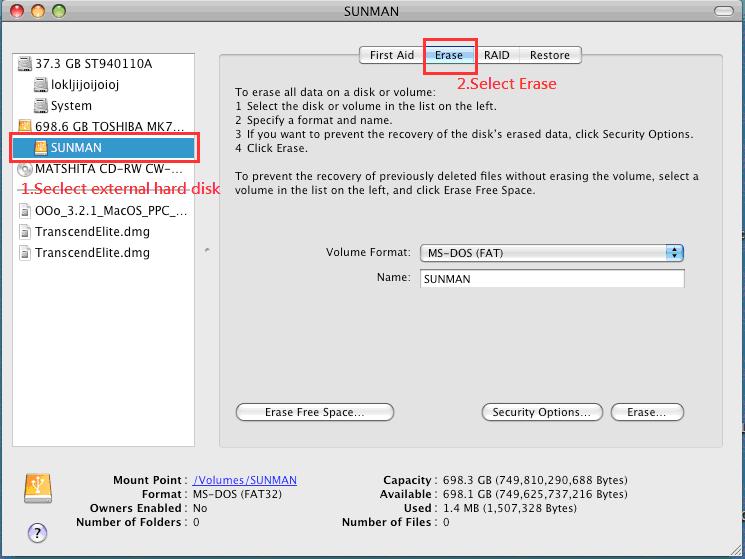
- #Making mount point for usb drive mac how to
- #Making mount point for usb drive mac mac os
- #Making mount point for usb drive mac install
- #Making mount point for usb drive mac upgrade

#Making mount point for usb drive mac install
Be sure to select the correct USB drive from the drop down! Once the Install Disc Creator is done (it might take some time), it will show you a dialog box saying the install drive has been made.

I used the app Install Disc Creator for this. Create a bootable USB with the 10.12.5 version of Sierra now present in your Applications folder.It will simply put the “Install macOS Sierra” package in your Applications folder. It will look like your current system will try to install Sierra on top of itself, but it won’t. Find and download the old macOS Sierra 10.12.5.I used this link on Apple’s Support site. The newest version of macOS Sierra provided by Apple.This USB drive be reformatted, so make sure you do not have any files on it before you begin, because this process will delete all the contents of the drive. A USB memory stick (16 GB minimum is recommended, but 8 GB might work too).My solution requires version 10.12.5 of macOS Sierra, which I could not find anywhere on the official channels ( the official link for the old version did not work at the time of writing), but I was able to find the OS by doing some simple googling.įor anybody else having this issue, here is a step by step guide. Many users report running in the “not a valid volume mount point” error or the “This copy of the install macOS Sierra application is damaged, and can’t be used to install macOS” - and so did I.Īfter five hours of experimenting, I finally found a solution. This is usually smooth sailing, but recent changes to Apple’s certificates for macOS Sierra causes a bug that makes it incredibly challenging to mount the OS to a USB drive to run the upgrade.
#Making mount point for usb drive mac upgrade
I quickly discovered that due to a firmware upgrade, I had to install macOS Sierra before being able to upgrade to the latest OS supported by my machine. Be patient.I recently got a Mac Pro 5,1 (2010) equipped with a new SSD. Wait for the return of the Terminal prompt signifying the process has completed. You will be asked for your admin password. Sudo /Applications/Install\ OS\ X\ Mavericks.app/Contents/Resources/createinstallmedia -volume /Volumes/MyVolume -applicationpath /Applications/Install\ OS\ X\ Mavericks.app Sudo /Applications/Install\ OS\ X\ Yosemite.app/Contents/Resources/createinstallmedia -volume /Volumes/MyVolume -applicationpath /Applications/Install\ OS\ X\ Yosemite.app Sudo /Applications/Install\ OS\ X\ El\ Capitan.app/Contents/Resources/createinstallmedia -volume /Volumes/MyVolume -applicationpath /Applications/Install\ OS\ X\ El\ Capitan.app Sudo /Applications/Install\ macOS\ Sierra.app/Contents/Resources/createinstallmedia -volume /Volumes/MyVolume -applicationpath /Applications/Install\ macOS\ Sierra.app Sudo /Applications/Install\ macOS\ High\ Sierra.app/Contents/Resources/createinstallmedia -volume /Volumes/MyVolume -applicationpath /Applications/Install\ macOS\ High\ Sierra.app Paste that entire command line from below at the Terminal's prompt: Choose the appropriate command line (in red) depending upon what OS X installer you want. Open the Terminal in the Utilities' folder.
#Making mount point for usb drive mac mac os
Set the Format type to Mac OS Extended (Journaled.) In the drop down panel set the partition scheme to GUID.Click on the Erase tab in the Disk Utility toolbar.After Disk Utility loads select the drive (out-dented entry with the mfg.'s ID and size) from the side list.Open Disk Utility in the Utilities' folder.You must have a copy of the Installer application in your Applications folder.

You will need an 8GB or larger USB flash drive that has been partitioned and formatted for use with OS X. Simply replace the Terminal command with the one from the preceding article by copying it into the Terminal window.
#Making mount point for usb drive mac how to
Second, see this How To outline for creating a bootable El Capitan installer. Bootable USB Installers for OS X Mavericks, Yosemite, El Capitan, and Sierraįirst, review this introductory article: Create a bootable installer for macOS.


 0 kommentar(er)
0 kommentar(er)
